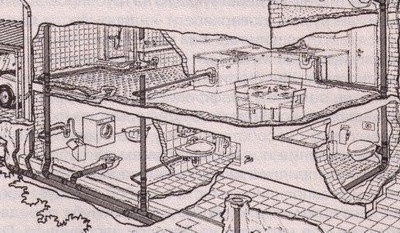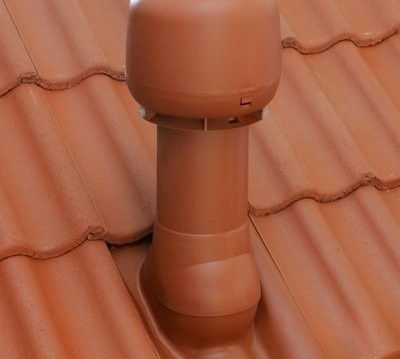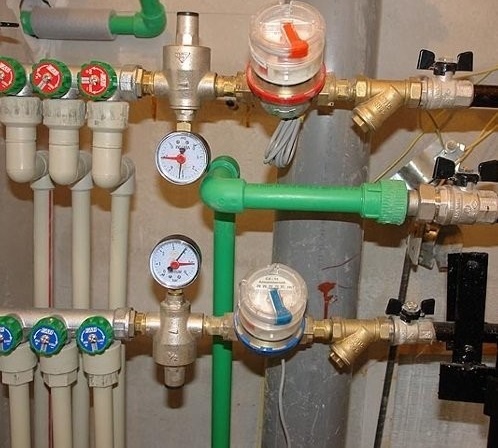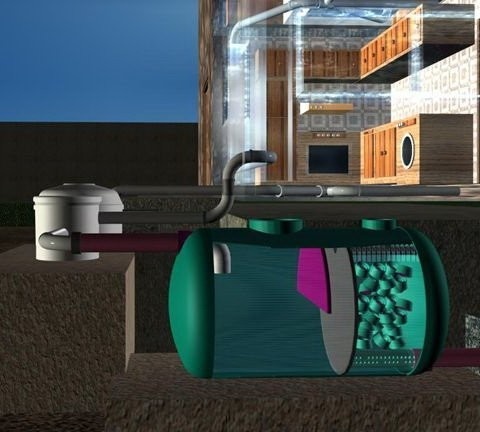Internal sewerage in a private house: design and installation rules + analysis of common errors
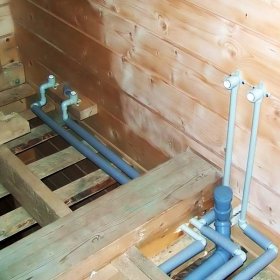
Modern man is spoiled by civilization. Sewerage, which not so long ago seemed a component of luxury housing, today has become an integral part of almost any apartment. Those who live in multi-storey well-maintained houses do not have to think about designing and installing this system, but the owners of individual buildings have to deal with it more difficult. Internal sewerage is a rather complicated system. The effectiveness and reliability of its operation directly depends on the design and installation of the structure. How to avoid errors in the process of arranging the system? Let's get it right.
Content
Where to start construction work?
The arrangement of the internal sewage system involves the installation of riser pipes for pipes and the installation of piping in the premises. It is best to take care of the discharge system at the design stage of the building and arrange all the “wet” rooms at a minimum distance from each other. Ideally, make them adjacent, so you can greatly simplify the arrangement of the internal sewage system. It is also important to correctly determine the location of the collector pipe, to which all pipelines will converge.
Now you can begin to develop a scheme for future sewage:
- Following the scale, we draw a plan of the building.
- We mark on it the location of the risers.
- We put on the scheme all the plumbing fixtures that are planned to be installed. We note for ourselves the features of their connection.
- We draw pipelines that will connect the risers and plumbing equipment. We mark all the necessary turns, joints, etc. Be sure to indicate the connecting elements that are required for mounting tees, bends, etc.
- We determine the parameters of the riser and fan pipe.
In accordance with the scheme, the system will subsequently be installed, in addition, it will help determine the amount of necessary materials.
Now you need to choose the method of laying the pipe. There can be two: hidden and open. In the second case, the trunk is mounted on a wall or floor. The first is more time-consuming and involves the execution of the strob in structures in which pipes are subsequently laid. When choosing this option, experts advise to lay the internal water and sewer pipes in one strobe. The water supply is above, and the sewerage is below. This is very convenient, since the time required for installation works and their volume are reduced.In addition, much less material is needed to seal the strobes.
Here is an example of such work:
Important points in system design
When designing an internal sewage system, the following aspects must be taken into account:
- For a gravity system, and the internal sewerage is such, it must be maintained pipeline angle. For pipes with a diameter of 50 to 80 mm, it is 2 cm per meter, for products with a diameter of 80-100 mm, the slope increases to 3 cm per meter.
- The drain pipes of the dishwasher and the kitchen sink are necessarily equipped with grease traps.
- The toilet should only be connected to the riser with a pipe with a diameter of at least 100 mm.
- For a house with several floors, the diameter of the riser should be 100-110 mm. Hatches for cleaning must be installed on it.
- It is best if there is only one sewer riser in the house. All branches of the internal sewer system will approach it.
- The location of the outlet of the pipeline is determined by the location of the prefabricated well, which should be installed at the lowest point of the site. The output is located in the wall closest to the well.
By following these simple rules you will avoid many problems.

Internal sewage can be laid in a hidden or open way. The first option involves the implementation of the shtrob, in which pipes are laid, which makes it difficult enough for the arrangement. The second is much simpler in execution, but less aesthetic
Choosing parts for the pipeline
First of all, we determine the material from which the elements are made.
Option # 1 - cast iron pipes
Some time ago there was simply no alternative to such details. Among their advantages can be attributed to durability, such pipes serve more than half a century, high strength and fire resistance. At the same time, cast iron is not sufficiently resistant to shock point loads, from which it should be protected whenever possible. The disadvantages of the material include a very large weight, high cost and complicated installation. In addition, the inner surface of such pipes is roughened, which contributes to the deposition of layers, which over time can completely block the path of sewage.
Option # 2 - polypropylene products
The advantages of such elements are resistance to all types of corrosion and solutions of salts, alkalis and acids, durability, high temperature resistance. The latter quality allows parts to easily tolerate both low and high temperatures, which makes it possible to lay them in almost any conditions.
Another advantage is increased fire resistance. Polypropylene is able to withstand a fire for a rather long time and not release toxic substances. Attractive and affordable cost. Some difficulty is the installation of parts, which require special equipment.

The most popular are plastic pipes for sewage. They are characterized by lightness, ease of installation and a smooth inner surface, which prevents the appearance of growths on the inner walls of parts
Option # 3 - PVC parts
Can be made from non-plasticized or from plasticized polyvinyl chloride. Characteristics of products from these materials are similar. The advantages of PVC pipes include a low coefficient of thermal expansion, which allows products to not increase and not sag when heated, as well as resistance to UV radiation. In addition, a very large assortment of fittings is produced, which makes it possible to assemble a pipeline of any configuration.
The disadvantages of products include fragility at low temperatures, low resistance to fire and the release of toxic substances during combustion, as well as sensitivity to certain chemicals.
General installation rules
Internal sewage in a private house is equipped with a number of rules:
- Elements of risers with a rotation of 90 ° are assembled from two elbows made of plastic, rotated by 45 °. If the pig-iron pipeline is mounted, two branches on 135 ° are used.
- In order to be able to eliminate possible blockages in the pipeline sections, a 45 ° oblique plastic or cast-iron tee with a plug and one elbow or cast-iron bend is installed. For example, a 45 ° plastic elbow will fully correspond to a cast iron elbow of 135 °.
- The branch pipelines, which are located in the basements, under the ceiling of the premises are connected to the risers using crosses or oblique tees.
- The height from the bottom of the horizontal socket of the tee or straight cross to the floor should be no more than 20 mm.
- The length of the pipeline from the toilet to the riser should not be more than 1 m. For other plumbing fixtures - not more than 3.5 m.
- To make turns on risers or at places of transition to horizontal sections, you can use 90 ° crosses or straight tees.
- To prevent the appearance of odors from the sewer in the room, an exhaust hood is necessarily equipped. The so-called fan pipe is led out through the roof to a height of about 0.7 m. It is unacceptable to connect it to a chimney or ventilation.
- If a fan pipe installation impossible, a special air valve for sewage is mounted.
- The diameter of the riser should be equal to the diameter of the exhaust part. With a single hood, you can combine two or more risers on the top floor or in the attic. The horizontal sections of such a pipeline are fixed with hanging brackets or simply wire to the rafters.
- On risers, which have no indentation in the upper and lower floors, revisions for sewage are installed. The standard height of the arrangement of the audit is 1000 mm from the floor level. If the part has to be installed in the corner of the room, it should be deployed at an angle of 45 ° relative to the walls.
- When installing the internal sewage system, all plastic pipes passing through the floors are installed in special metal sleeves. Element height depends on the overlap width. The top of the part should protrude 20 mm from the floor level, and the bottom should be flush with the ceiling.
- The riser is installed with the sleeve on. In order for it not to fall from the pipe, it is tied with a thin wire to a higher socket of a spider or tee or burst with pieces of polystyrene foam.
- If it is assumed that a toilet and other plumbing fixtures will be connected in series on a horizontal section, an adapter for sewage must be installed between them. Plastic parts cannot be turned high. This threatens problems with the subsequent connection of equipment, especially with a shower or bath. On average, a turn should be carried out at half the tee in height with a direction towards the wall.
- To secure the sewer use clamps. Plastic pipes are mounted on horizontal sections as needed, so that there are no fractures. On average, one clamp per half meter is installed - a meter of the length of the trunk.
- Cast iron pipes are mounted on steel brackets with a bend at the end, which prevents the displacement of the pipeline. Fasteners are installed under each pipe near the socket.
- The risers are fixed to the side walls with 1-2 clamps on the floor. Fasteners are installed under the bells.
It is important to note that at the end of installation work, tests for leaks are mandatory.
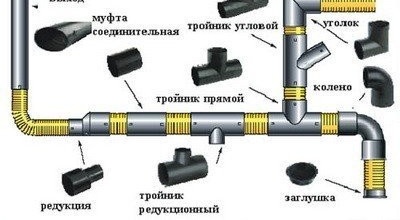
For the arrangement of internal sewage, various connecting elements are used.It should be borne in mind that the same cast-iron and plastic elements can differ in names and markings.
Sewerage is a necessary element of any comfortable home. Its arrangement does not require special special knowledge, but, at the same time, it cannot be called a simple matter. There are many nuances and features of the arrangement of the system. You should start with the development of a pipeline laying scheme, which will become the basis for subsequent work and will help to correctly calculate the amount of necessary materials. Already at this stage, you can evaluate your strengths and understand whether you will be able to cope with the work yourself or whether you will need to look for helpers. Many companies specialize in the provision of plumbing services. Professionals will quickly and competently install the sewer system of any complexity.
